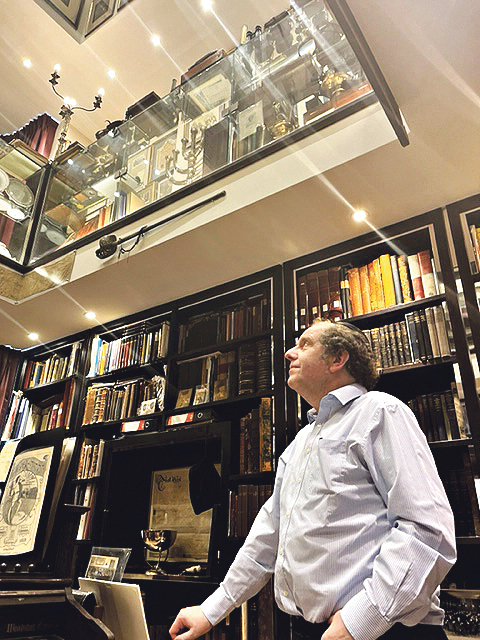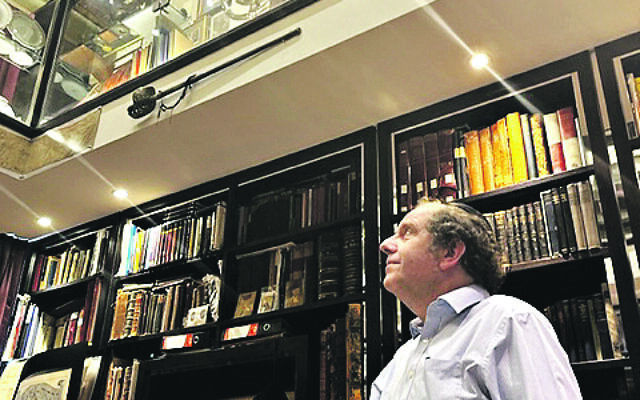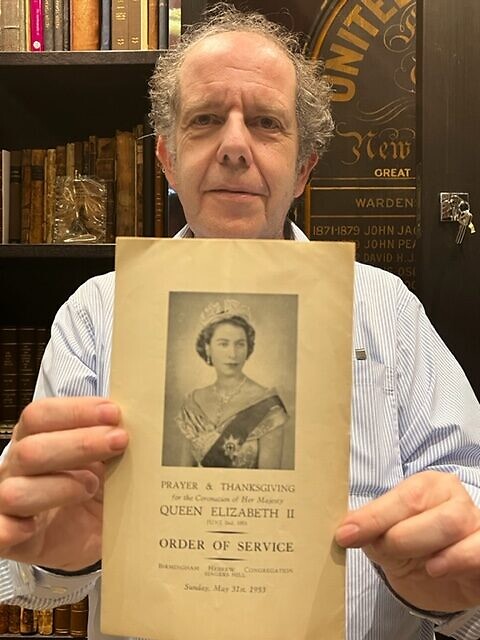A history of Jewish life in Britain, one extraordinary artefact at a time
David Latchman began his incomparable collection charting the history of UK Jewry aged just 18, with a book bought for a pound.
Jenni Frazer is a freelance journalist
In a quiet suburban road in London, a cheerful academic is rejoicing in talking about the things he loves best – an extraordinary collection of Judaica, charting the history of Anglo-Jewry.
Privileged visitors are faced with a cornucopia of objects, each one with its own fascinating story, both of its place in history and of professor David Latchman’s adventures in acquiring it. In every corner, there are shelves and display cases: here a run of antiquarian books, there a collection of china representing Jewish pedlars.
There are scientific instruments made by Jewish craftsmen and gorgeous silver ornaments – including a crown I recognise, from a Torah scroll from my own now defunct shul in Manchester.
There’s a sword once carried by a Jewish officer in the First World War; a giant menorah that used to belong to the B’nai B’rith lodges. There is a silver coin on which the bare-knuckle boxer Daniel Mendoza is depicted; and a deed dating from the 13th century in which it is stipulated that a piece of land in Yorkshire should not be sold to Jews.
There’s a door-sized display board of the honorary officers of the New Synagogue in Great St Helens, Bishopsgate, dating from 1871, with members of the unlikely-sounding Jewish Peartree family recorded as wardens and financial officers. There are countless paintings of solemn but anonymous rabbis, and just as many of identifiable chief rabbis and of that 19th century colossus of Anglo-Jewry Sir Moses Montefiore. There’s a gorgeous portrait of the war poet Isaac Rosenberg
There are numbers of orders of service, particularly for state occasions such as the present Queen’s coronation; and there is furniture, too, such as rabbinical pews from long-closed synagogues, and a recent acquisition, a beautiful organ from Manchester’s Higher Broughton Synagogue, “kept under the stairs and rolled out on Sundays for weddings”.
There are numbers of orders of service, particularly for state occasions such as the present Queen’s coronation
The sheer breadth of Latchman’s collection is stunning, easily rivalling any museum I’ve ever visited. But, as he tells it, he began collecting almost by accident, buying a book on Montefiore – “it cost £1” – when he was just 18.
His collecting passion predated his Judaica, he says. “As a teenager, I used to buy books, Ian Fleming, for example, going to all the WH Smith outlets to see what they had. But eventually I realised you could order them, so there was no great excitement in that. Then I started buying second-hand books – but I still ended up with a lot of random things that took my fancy”.
The early scientist in Latchman – he is a geneticist who is vice-chancellor of Birkbeck University – led him to decide to restrict what he was collecting. “The problem with science books is that even when you’re experienced, it’s very hard to know what’s right and what’s wrong. So I thought: ‘Keep it separate from science, I’ll collect Judaica.’”
For a long time, he says, he “just” collected books but, by degrees, he branched out, always curious to link the history of a synagogue with an illustrated manuscript, a painting or a piece of anniversary silver.
“I am very, very, very strict. I don’t buy anything that doesn’t have some connection with Britain; and if I want to buy something, it’s got to have some justification as to why it fits in the collection.”
He describes himself as a “completist”, who spends considerable time ensuring he has, for example, every book by a particular author or every portrait of a specific rabbi. But, inevitably, he can’t buy everything and there are occasions when he is beaten by another bidder at auction, or when he “lusts” after a rare item he just hasn’t managed to lay his hands on – yet.
“I am very, very, very strict. I don’t buy anything that doesn’t have some connection with Britain; and if I want to buy something, it’s got to have some justification as to why it fits in the collection.”
It’s hard not to get caught up in Latchman’s enthusiasm and recognise that the thrill of the chase is sometimes as enjoyable as an item’s acquisition. Over the years, he has built up an enviable expertise and judgment as to what constitutes a rare collectible.
He clearly adores everything he’s bought, but has his favourites.
The Jewish Museum, he explains, has a title deed recording the purchase of a piece of land in the late 1670s. The buyer was Benjamin Levy, essentially the founder of the Ashkenazi community in London. This deed does not show what Levy bought it for but merely records the sale from a non-Jew.
But Latchman has a deed written the next day, showing Levy giving the land to the members of the Great Synagogue in Duke’s Place, for what was to become Alderney Road cemetery, the first Ashkenazi burial plot in England. “I think of this as the foundation document of the Anglo-Jewish community,” he affirms.
Latchman hasn’t yet made up his mind as to the future of his collection – on which he’s not prepared to put a value.
There are even more arcane items in the collection that might pass most of us by. Does he have anything in Yiddish? David produces an extraordinary 1899 guidebook, which was aimed at Yiddish-speaking tourists to London. I make out details for visiting the Tower of London, along with adverts for tooth cleaners.
Or he’s rather fond of an unpromising-looking little pamphlet, about the size of a cigarette packet and consisting of just a few pages. This turns out to be a coach timetable – in Yiddish – for Jewish pedlars, going from inn to inn the length of 19th century Britain. It’s an extremely rare item, because often, after consultation, such timetables were thrown away.
Elsewhere there are bigger objects, including an impressive gleaming brass telescope made by one of a cadre of Jewish instrument makers, Abraham Abraham, who was, he says, “not just Jewish but embedded in the community”.

Latchman hasn’t yet made up his mind as to the future of his collection – on which he’s not prepared to put a value. Meanwhile, he’s working on a new book, arising from his passion – the stories of 10 chief rabbis, going back to Aaron Hart, in 1705.
It consists of material he couldn’t get in his first book, to mark the United Synagogue’s 150th anniversary.
All being well, it should be ready for Jewish Book Week 2023.
Mention of Aaron Hart leads us, inexorably, to talk of Lemon Hart, who gave his name to the eponymous rum – and who was born Lehman Hart in Penzance, Cornwall, in 1768, the grandson of a Jewish immigrant from Germany.
For every item, there is a story – the wilder the better. And it all began with one book, bought for a pound.

Thank you for helping to make Jewish News the leading source of news and opinion for the UK Jewish community. Today we're asking for your invaluable help to continue putting our community first in everything we do.
For as little as £5 a month you can help sustain the vital work we do in celebrating and standing up for Jewish life in Britain.
Jewish News holds our community together and keeps us connected. Like a synagogue, it’s where people turn to feel part of something bigger. It also proudly shows the rest of Britain the vibrancy and rich culture of modern Jewish life.
You can make a quick and easy one-off or monthly contribution of £5, £10, £20 or any other sum you’re comfortable with.
100% of your donation will help us continue celebrating our community, in all its dynamic diversity...
Engaging
Being a community platform means so much more than producing a newspaper and website. One of our proudest roles is media partnering with our invaluable charities to amplify the outstanding work they do to help us all.
Celebrating
There’s no shortage of oys in the world but Jewish News takes every opportunity to celebrate the joys too, through projects like Night of Heroes, 40 Under 40 and other compelling countdowns that make the community kvell with pride.
Pioneering
In the first collaboration between media outlets from different faiths, Jewish News worked with British Muslim TV and Church Times to produce a list of young activists leading the way on interfaith understanding.
Campaigning
Royal Mail issued a stamp honouring Holocaust hero Sir Nicholas Winton after a Jewish News campaign attracted more than 100,000 backers. Jewish Newsalso produces special editions of the paper highlighting pressing issues including mental health and Holocaust remembrance.
Easy access
In an age when news is readily accessible, Jewish News provides high-quality content free online and offline, removing any financial barriers to connecting people.
Voice of our community to wider society
The Jewish News team regularly appears on TV, radio and on the pages of the national press to comment on stories about the Jewish community. Easy access to the paper on the streets of London also means Jewish News provides an invaluable window into the community for the country at large.
We hope you agree all this is worth preserving.

























